My first trekking expedition in Rio Grande do Norte/Paraíba was to Pedra da Boca. I believe I started off well, and I was really excited about this first experience. That’s why I’ll try to bring the best content to you.
The adventure begins at Pedra da Boca in Araruna – Paraíba. It’s located on the border between Rio Grande do Norte and Paraíba, and since RN is a small state, it allows for short road trips to places like Parque de São Bento, Maracajaú, and Pico do Cabuji, for example, all within a few hours.
I had the opportunity to visit this place with the group @_euescolhitrilhar, and through Thiago, I got all the support I needed to travel from Natal to Pedra da Boca. I also camped there and explored two trails in the area.
I believe the experience at Pedra da Boca opened my eyes to new possibilities and motivated me to pursue the dream of traveling while working. Keep reading to find out everything about the adventure to Pedra da Boca!
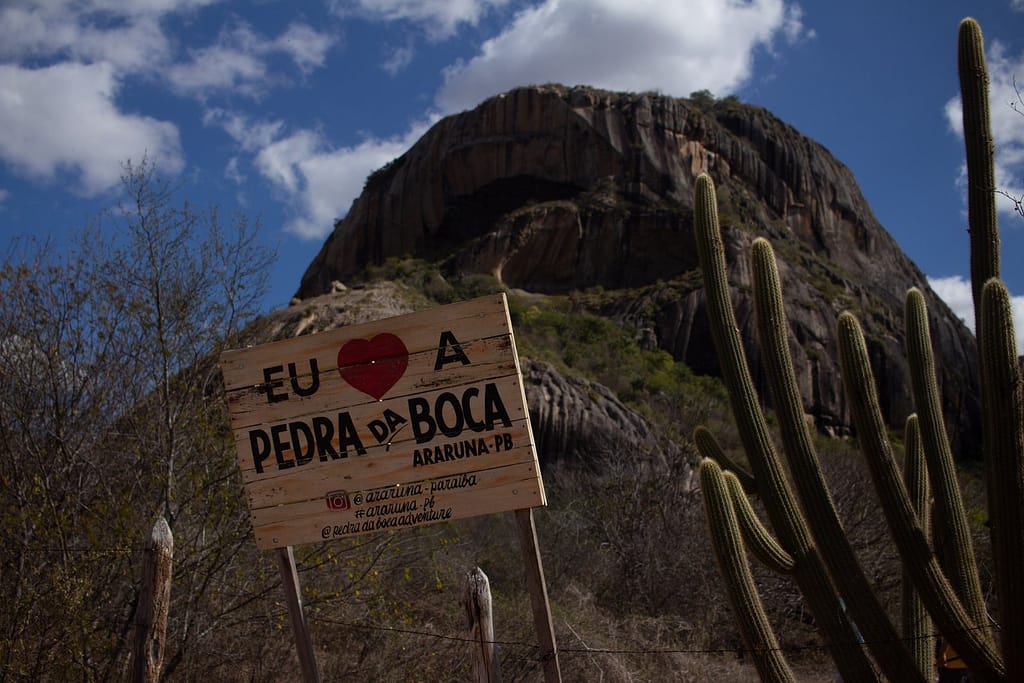
Pedra da Boca State Park
Pedra da Boca is named this way due to the shape of the inselberg, which resembles an open mouth. It has existed for almost 600 million years, a result of geological processes. It’s one of the rock formations that are part of the Pedra da Boca State Park.
The Pedra da Boca State Park was created by a government decree in 2000. Before that, there were already inhabitants in that region, which borders the states of Paraíba and Rio Grande do Norte. One of them is the park’s guide, “Seu Tico,” who, in addition to guiding, shares his history with us and shows the region.
Ecotourism
The trails in the Pedra da Boca State Park offer an incredible view of the caatinga. If you love adventure, there are trails in this park that provide a good adrenaline rush—especially for those experiencing their first hiking trip with camping, like I did!
It was totally worth it!
Besides Pedra da Boca, there are other well-known rocks such as: Pedra da Caveira, Pedra da Santa, Pedra do Lagarto, Pedra do Letreiro, and Pedra do Forno. There are also caves like Gruta do Aventureiro, Gruta da Mesa, and Gruta do Caçador.
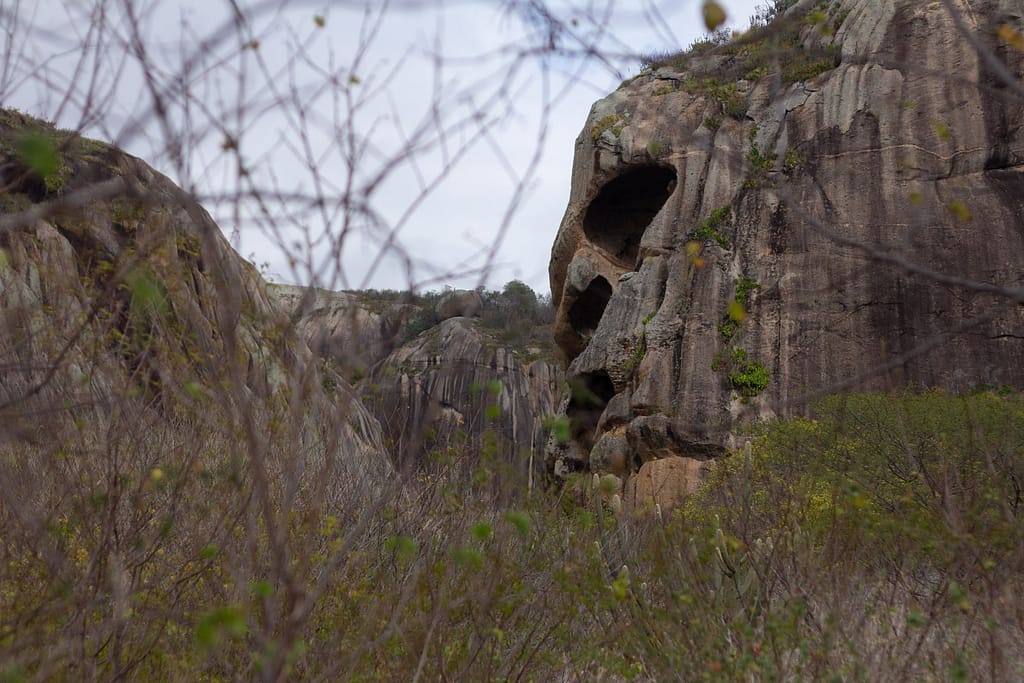
You’ll pass by all of them and also have the chance to see prehistoric cave paintings and have a wide view of the northeastern caatinga. Prehistoric humans walked through this land, and the rock formations provide a deep connection with the earth and its history.
Religious Tourism
At Pedra da Santa, it’s possible to participate in pilgrimages that take place every 13th of the month. Especially the “Romaria da Fé,” which happens on May 13th at the Nossa Senhora de Fátima Sanctuary, where Catholics gather to pray for peace and protection from Nossa Senhora against any form of violence towards life and nature.
Where is Pedra da Boca? Rio Grande do Norte or Paraíba?
The Pedra da Boca State Park is located on the border between Rio Grande do Norte and Paraíba, belonging to the state of Paraíba and closer to the municipality of Passa e Fica – RN.
How many kilometers from Natal to Pedra da Boca?
From Natal to Pedra da Boca, the distance is approximately 110 km, and you have two options to reach the site. If you’re driving from Natal, you pass through Parnamirim, then follow RN-316 to Brejinho. From there, you take RN-160 to Santo Antônio and then follow RN-003 to the Lagoa D’anta gas station, where you turn onto RN-093 until you reach Passa e Fica.
Check out our travel guides to Natal and João Pessoa!
Another safer route for those who prefer not to venture through the rural areas of RN is to take BR-101 to Goianinha, then follow RN-003, passing through Santo Antônio and turning onto RN-093 at the Lagoa D’anta gas station until reaching Passa e Fica. Both routes take around 2 hours by car.
I noticed some mobility challenges with public transportation to reach certain towns in Rio Grande do Norte. So, if possible, I recommend renting a car. The advantage is that the state is small, and car trips usually don’t last long.
You can also book your expedition with Civitatis departing from João Pessoa!
Hike Preparation
The hike within the Pedra da Boca State Park are short. You can complete them in a day with smaller groups. However, the place offers a series of natural beauties and adventures that make camping in the area worthwhile. Follow along for the preparation for adventures at the Pedra da Boca State Park.
Camping
I camped in “Seu Tico’s” backyard! Besides being a guide, he owns a restaurant and offers a space with a bathroom and shower for those who want to camp. You can enjoy this space for just R$ 5.00 (US$ 0,87/ € 0,79) per person (as of 2021). The location of “Seu Tico’s” campsite is perfect, being very close to Pedra da Boca and Pedra da Caveira.
Equipment
The equipment I used for this trail included a simple pair of walking shoes for asphalt, a regular backpack, and a 50-liter Nord backpack (it was new, and I was eager to test it!), as well as a two-person Nautika tent. Clothing should be lightweight, and it’s a good idea to bring sunscreen since the sun in RN can be harsh.
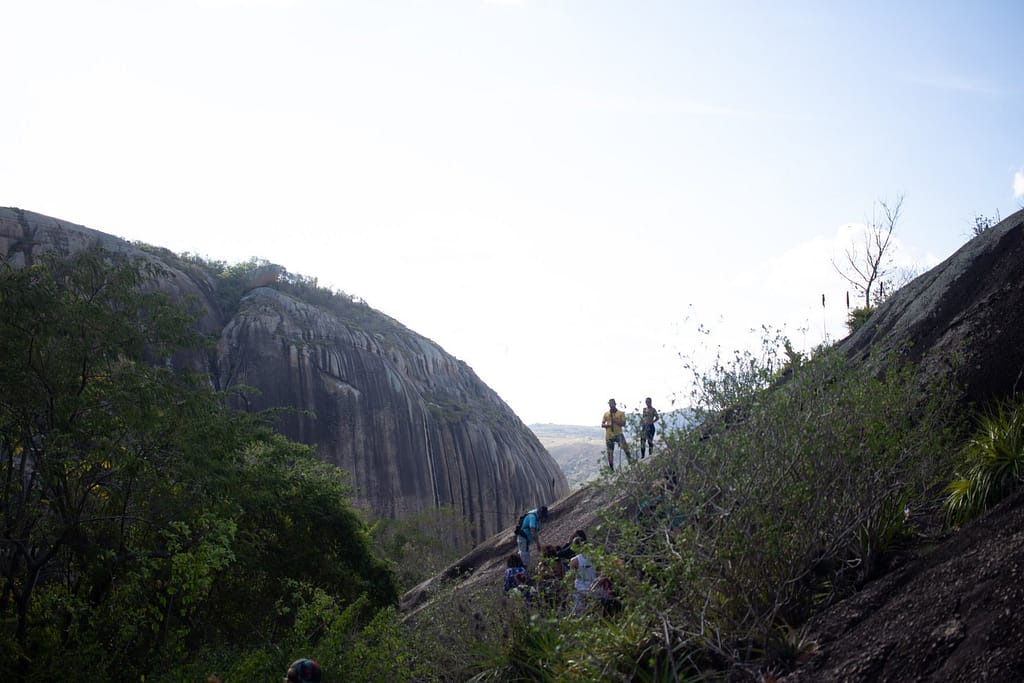
A word of caution about the shoes I wore! Since they were new, they gave me more grip on the surface. Being a granite rock, it can be a bit slippery if the soles are worn out. So, make sure to wear comfortable shoes, preferably hiking boots for light trails.
Food
The site does not have a place to refrigerate or heat your food. Therefore, it’s advisable to bring light and practical food items such as nuts, peanuts, rapadura (a type of sugar cane sweet), raisins, sunflower seeds, cereal bars, and biscuits. If you plan to stay overnight, consider bringing something more substantial for breakfast. In my case, I brought bread, canned tuna, and Polenguinho cheese.
It’s also possible to have your main meals at “Seu Tico’s” restaurant, where lunch cost R$ 17.00 (US$ 2,96 / € 2,70) each, and breakfast and dinner had separate prices. It’s self-service, and the food is tasty. If you plan to have lunch, go early, as the place tends to get quite crowded.
If you’re planning to visit Pedra da Boca, travel insurance is something you shouldn’t skip. The park is perfect for hiking, climbing, and exploring nature, but these kinds of adventures always come with a bit of risk. Having travel insurance ensures you’re covered in case of accidents, health issues, or unexpected changes in your trip.
You can book your plan through our affiliate link, it doesn’t cost you anything extra and helps us keep Do in Brazil running to bring more travel guides and tips for exploring Brazil safely.
What to do at Pedra da Boca
I heard a story about camping on top of a rock. I believe it’s possible, but it would probably only be safe with a group. Still, the idea sounds cool. I stayed two days in that place, and it was a wonderful experience. Read below and enjoy.
Trails
The trails are well-marked and become even more interesting with “Seu Tico,” who survived in the caatinga for many years. Now, he gives a lesson about the park’s vegetation, shows us the caves, and leads us to explore the local rock formations.
Some trails will require physical effort, involving climbing and the use of ropes to reach certain points, especially at the end of the Pedra da Boca climb. The view from the top is amazing—seeing the horizon from that height is surreal, making you feel small in such vastness.
There are a total of six trails, and the one we took went towards a fork between Pedra da Boca and another rock, where we climbed to the highest point and exited from there.
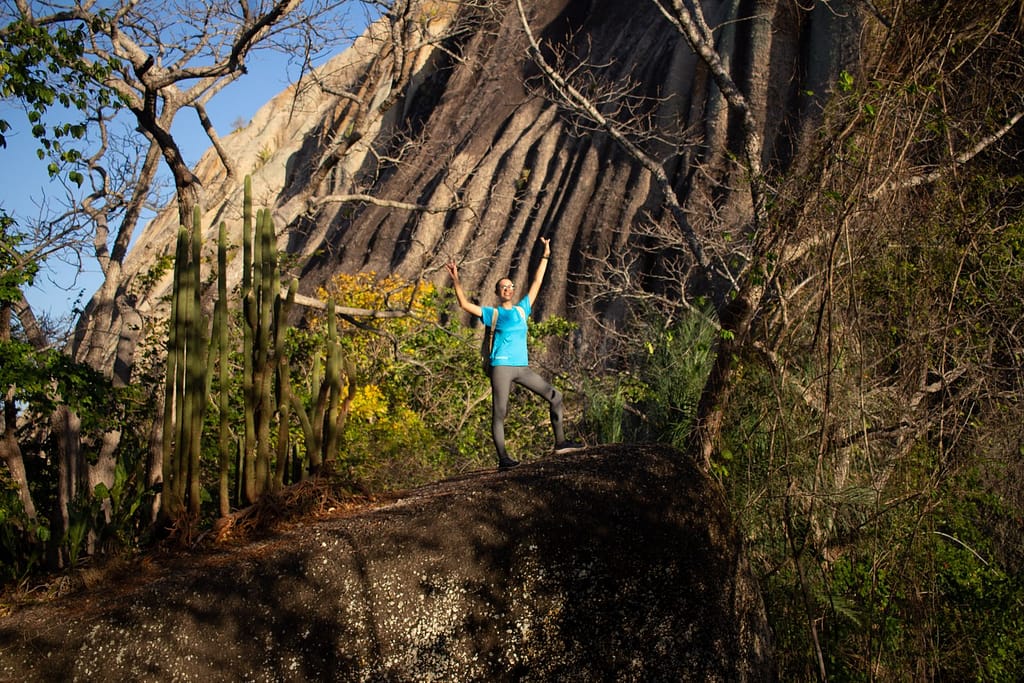
Extreme Sports
You can also engage in extreme sports like rappelling, the pendulum, and zip-lining. They were priced at R$ 30.00 (US$ 5,22 / € 4,77), and if you’re up for facing your fear of heights, this is a great opportunity. Initially, it gives you butterflies, but once you feel safe with the equipment, everything flows more smoothly.
Nelson, my partner, and I did the pendulum at Pedra da Boca. You can even go upside down! It’s worth experiencing the thrill of being swung out from Pedra da Boca. Rappelling didn’t happen on the days we were there.
I also tried the “Salto do Carcará” zip line, and it was totally worth it!
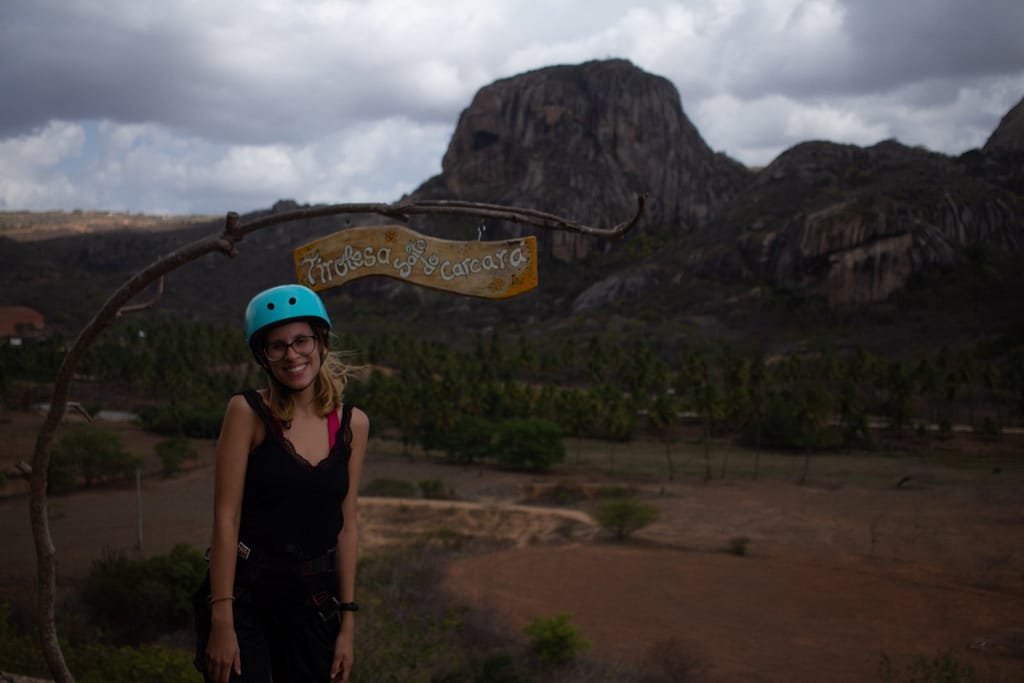
Weekend Itinerary at Pedra da Boca
My experience at Pedra da Boca lasted for two days, and the “I Chose to Hike” program left us thrilled with the trails and the stunning landscapes we saw there. Whether it was the classic ascent to Pedra da Boca or the hike we did within the Park, we were excited.
Our itinerary at Pedra da Boca State Park was incredible, and I can confidently say we started our adventures the right way! Read on for more details.
Saturday
I arranged to meet the group next to Natal Shopping, and we planned to leave at 10 AM. The drive takes about two hours, and the roads are easy to navigate with Maps.
I love hitting the road, and once we reached Passa e Fica, we could easily spot the massive rocks of the Park. Pedra da Boca stands out, immediately catching our eye, as it’s located just behind the campsite.
We arrived at the Park around noon, set up our tent, and went for lunch, as we planned to do the longer hike in the afternoon. Lunch at “Seu Tico’s” Restaurant is self-service, and I enjoyed it.
We hiked past Pedra da Boca, where we had our first climbing experience. With the help of ropes and the support of guides, we climbed the area, then continued behind it to visit the caves Olho D’água, Cama do Caçador, and Zamboca.
The entire trail is surrounded by dense vegetation, and the terrain alternates between granite rocks and packed earth. Regular hiking shoes work for walking on the rocks, but they can be a bit slippery, especially if the soles are worn out.
After passing through the caves, we exited in front of Pedra da Caveira. The shape and depth of those cavities are astonishing. We went straight back to the campsite to shower, have dinner, and rest. The climb and all the experiences left us happy but exhausted. 🙂
Sunday
The first hours in the caatinga are pleasant, with cool temperatures and the rocks providing a beautiful view of what Sunday would bring. First, I showered and prepared our things for the day before breakfast.
Since we only planned to hike Pedra da Boca and do the Carcará Zipline that day, we decided to take down the tent and leave everything ready for our return to Natal. Once everything was packed, we started the ascent to Pedra da Boca.
The hike has various types of inclines. At some points, you can walk upright, but in others, you need to use your hands, and as you approach the top, you have to rely on ropes for support. At the rope section, the height is daunting—it’s very steep, and it feels like you might fall if you let go. It’s thrilling!
The view from Pedra da Boca is surreal. From this relatively high vantage point, you can see the other rocks in the Park and the horizon stretching out before you. It’s stunning. At Pedra da Boca, you can also do the pendulum for R$30 (US$ 5,22 / € 4,77), where you’re suspended by a rope and swung out of the crater three times—it feels like flying!

We returned to the campsite along the same path. Although the descent seems easy, it requires more attention to avoid slipping or misstepping. The fear of falling from that height is enough to make your legs tremble!
We had lunch, chatted with the group, and prepared for the last adventure on the itinerary. The zipline is located outside “Seu Tico’s” campsite, heading toward the sanctuary.
At Pedra do Lagarto, the Carcará Zipline installations are in place. The zipline spans about 400 meters, and it costs R$30 (US$ 5,22 / € 4,77) per person. I was nervous about the jump, but after taking the plunge, it was super smooth and fun.
We returned to Natal at 3:30 PM that Sunday, happy and relaxed after all the weekend’s activities and excited for the next adventures.
Weekend Prices at Pedra da Boca
We signed up for a package with the Eu Escolhi Trilhar (I Chose to Hike) group, which cost R$170 (US$ 29,57 / € 27,05) per person. This included camping, the guide, Park fees, and Sunday lunch. We covered Saturday’s lunch ourselves, which cost R$17, as well as the pendulum and zipline, which were R$30 (US$ 5,22 / € 4,77) per person.
Altogether, our expenses totaled R$504 (US$ 87,66/ € 80,19), which we found to be quite reasonable given the experiences it provided and the smooth organization of the trip. It was totally worth it!
The prices have likely increased a bit since we went in 2021, but I believe it remains an affordable option for connecting with nature close to Natal.
You can explore more tours through the Agreste region of Paraíba with Civitatis:
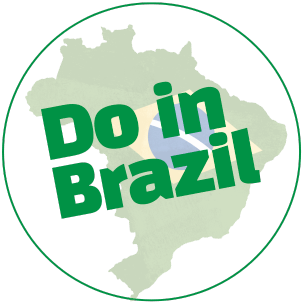




Pingback: Pico do Cabugi (Cabugi Peak): Discovering a Volcano in the Caatinga of Rio Grande do Norte - Do in Brazil
Pingback: Natal: Everything You Need to Know About What to Do in the Capital of Rio Grande do Norte, Brazil! - Do in Brazil